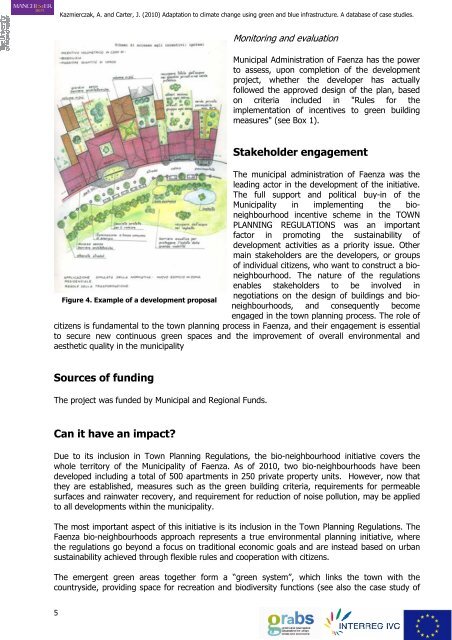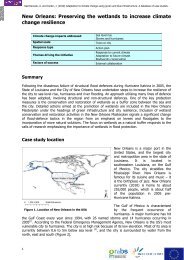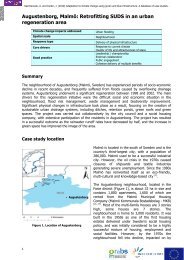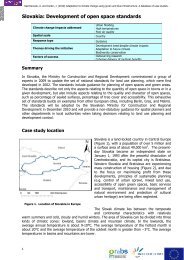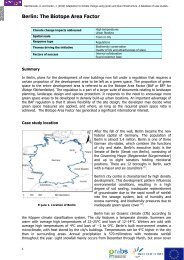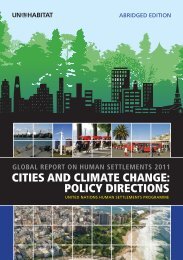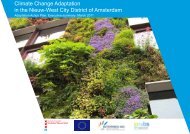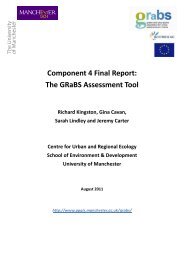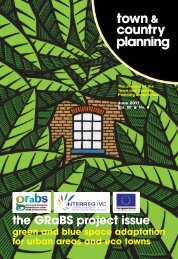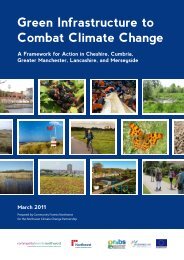Faenza: Extra cubature for developers in return for green ... - GRaBS
Faenza: Extra cubature for developers in return for green ... - GRaBS
Faenza: Extra cubature for developers in return for green ... - GRaBS
You also want an ePaper? Increase the reach of your titles
YUMPU automatically turns print PDFs into web optimized ePapers that Google loves.
Kazmierczak, A. and Carter, J. (2010) Adaptation to climate change us<strong>in</strong>g <strong>green</strong> and blue <strong>in</strong>frastructure. A database of case studies.<br />
Monitor<strong>in</strong>g and evaluation<br />
Municipal Adm<strong>in</strong>istration of <strong>Faenza</strong> has the power<br />
to assess, upon completion of the development<br />
project, whether the developer has actually<br />
followed the approved design of the plan, based<br />
on criteria <strong>in</strong>cluded <strong>in</strong> "Rules <strong>for</strong> the<br />
implementation of <strong>in</strong>centives to <strong>green</strong> build<strong>in</strong>g<br />
measures" (see Box 1).<br />
Stakeholder engagement<br />
The municipal adm<strong>in</strong>istration of <strong>Faenza</strong> was the<br />
lead<strong>in</strong>g actor <strong>in</strong> the development of the <strong>in</strong>itiative.<br />
The full support and political buy-<strong>in</strong> of the<br />
Municipality <strong>in</strong> implement<strong>in</strong>g the bioneighbourhood<br />
<strong>in</strong>centive scheme <strong>in</strong> the TOWN<br />
PLANNING REGULATIONS was an important<br />
factor <strong>in</strong> promot<strong>in</strong>g the susta<strong>in</strong>ability of<br />
development activities as a priority issue. Other<br />
ma<strong>in</strong> stakeholders are the <strong>developers</strong>, or groups<br />
of <strong>in</strong>dividual citizens, who want to construct a bioneighbourhood.<br />
The nature of the regulations<br />
enables stakeholders to be <strong>in</strong>volved <strong>in</strong><br />
negotiations on the design of build<strong>in</strong>gs and bioneighbourhoods,<br />
and consequently become<br />
Figure 4. Example of a development proposal<br />
engaged <strong>in</strong> the town plann<strong>in</strong>g process. The role of<br />
citizens is fundamental to the town plann<strong>in</strong>g process <strong>in</strong> <strong>Faenza</strong>, and their engagement is essential<br />
to secure new cont<strong>in</strong>uous <strong>green</strong> spaces and the improvement of overall environmental and<br />
aesthetic quality <strong>in</strong> the municipality<br />
Sources of fund<strong>in</strong>g<br />
The project was funded by Municipal and Regional Funds.<br />
Can it have an impact?<br />
Due to its <strong>in</strong>clusion <strong>in</strong> Town Plann<strong>in</strong>g Regulations, the bio-neighbourhood <strong>in</strong>itiative covers the<br />
whole territory of the Municipality of <strong>Faenza</strong>. As of 2010, two bio-neighbourhoods have been<br />
developed <strong>in</strong>clud<strong>in</strong>g a total of 500 apartments <strong>in</strong> 250 private property units. However, now that<br />
they are established, measures such as the <strong>green</strong> build<strong>in</strong>g criteria, requirements <strong>for</strong> permeable<br />
surfaces and ra<strong>in</strong>water recovery, and requirement <strong>for</strong> reduction of noise pollution, may be applied<br />
to all developments with<strong>in</strong> the municipality.<br />
The most important aspect of this <strong>in</strong>itiative is its <strong>in</strong>clusion <strong>in</strong> the Town Plann<strong>in</strong>g Regulations. The<br />
<strong>Faenza</strong> bio-neighbourhoods approach represents a true environmental plann<strong>in</strong>g <strong>in</strong>itiative, where<br />
the regulations go beyond a focus on traditional economic goals and are <strong>in</strong>stead based on urban<br />
susta<strong>in</strong>ability achieved through flexible rules and cooperation with citizens.<br />
The emergent <strong>green</strong> areas together <strong>for</strong>m a “<strong>green</strong> system”, which l<strong>in</strong>ks the town with the<br />
countryside, provid<strong>in</strong>g space <strong>for</strong> recreation and biodiversity functions (see also the case study of<br />
5


